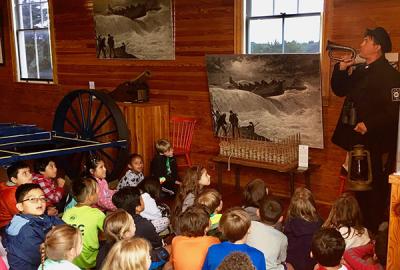History Alive in Amagansett

Seventy-six years to the day — June 13 — when a Nazi submarine ran aground on a sandbar off Atlantic Avenue Beach in Amagansett, third graders at the John M. Marshall Elementary School got a history lesson, as well as a few drama tips, when their teacher, David Cataletto, took them to the place where all the action had unfolded, the Amagansett Life-Saving and Coast Guard Station museum on Atlantic Avenue.
Mr. Cataletto, who grew up in East Hampton and attended the elementary school himself, donned a heavy wool sailor’s jacket and cap and dramatized the action of the brave Coast Guardsmen who manned the station between 1902 and 1945. The teacher animatedly recreated all the tension and bravery of the times and appointed the children his crewmen. If at any time their attention wandered, the teacher would call, “Attention!” to which the children would respond, “Aye aye, captain!” snapping right back into the moment.
“I am a huge history buff, especially local history,” wrote Mr. Cataletto in an email. “I am a trustee for the Life-Saving Station and the chairman of the education committee. My goal is to expose as many kids as possible to the museum and our local history.”
The history lesson took the children through the building, which was meticulous restored over eight years. After the Coast Guard Station was decommissioned in 1945 and was condemned for possible demolition, it was bought by Joel Carmichael for $1 in 1966 and moved to a plot of land on Bluff Road. In 2007, the family gave the building to East Hampton Town for $1 and the structure was returned to its original site, where it stands today.
Following their walk through the house, and a re-enactment of the events of June 13, 1942, when a young seaman foiled the Nazis’ plan to blow up munitions factories and other sites across the country, the teacher took them on a hunt for German supplies, which he said were buried on the beach.
Mr. Cataletto, who was a lifeguard growing up, once sailed to Canada single-handed. After graduating from East Hampton High School, he attended the University of Massachusetts, where he studied anthropology.
“I wanted to be a maritime archaeologist but that never panned out,” he said. After teaching in New York City public schools for several years, he moved back to East Hampton eight years ago.
“My favorite part of teaching kids is to make history come alive for them. So many people think history is old, dusty, boring books but it can actually be very exciting,” he said.
The kids certainly seemed to agree as they excitedly uncovered the buried “treasure” on the Amagansett beach: stickers and granola bars.
